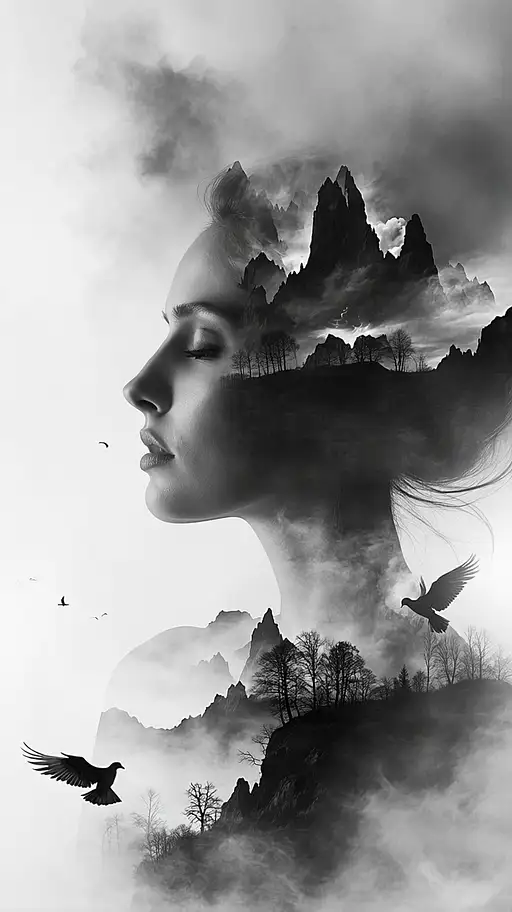


7 months ago
A dramatic, front-facing close-up portrait of Mariano Rajoy in a suit, reminiscent of the T-1000 from Terminator 2. The composition is perfectly symmetrical, with his face divided vertically into two distinct visual styles. The left half is hyper-realistic, emphasizing lifelike skin textures, sharp cheekbones, and piercing, determined eyes under cinematic lighting that enhances his cold, authoritative presence. The right half is a seamless transformation into liquid metal — smooth, reflective, and in constant, subtle motion — evoking a futuristic, shape-shifting machine. His expression is calm, composed, and exudes quiet menace and unshakable focus. The division between the two halves is jagged and organic, like torn steel or cracking ice, symbolizing the fusion of human form and advanced technology. A muted, minimal background ensures all focus remains on his iconic, intimidating face, highlighting the stark contrast between man and machine.
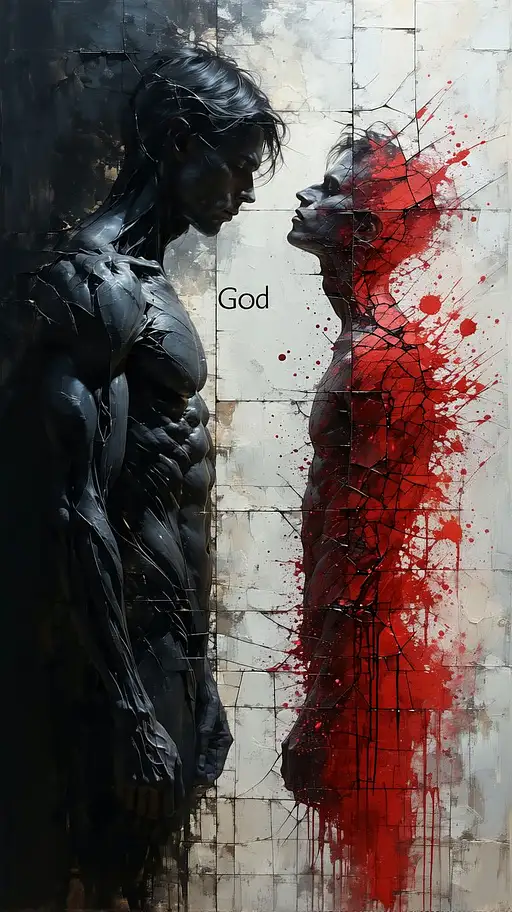
3 months ago
A surreal human figure standing before a cracked antique mirror. One half of the real body (left side) is drawn in intricate black lineart—minimal, structured, eyes closed in serenity—etched with fine veins that subtly form the word “Good” across the chest in flowing gothic calligraphy. The mirrored reflection (right side) explodes in red swirling ink splatters—chaotic, expressive, almost violent—with the word “Bad” emerging in brutalist, bleeding letters across the reflection’s chest. The mirror is fractured, each shard distorting parts of the red reflection. Background is a dim, moody void with drifting particles, like dust in still air. Soft chiaroscuro lighting, 8K detail, emotional tension, symbolic, psychological surrealism, cinematic tones, textured like old photo film.
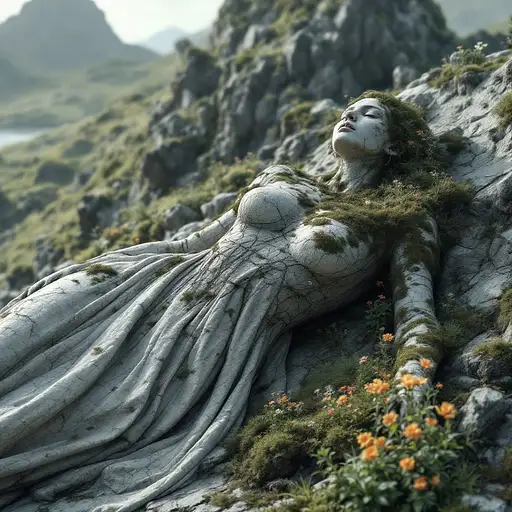
5 months ago
A masterpiece, best quality, official art, extremely detailed 8k wallpaper, absurdres, 8k resolution. A massive clothed female figure lying on her side, sculpted from weathered stone and earth, partially covered in moss and grass. Her body blends seamlessly into the surrounding terrain — hills and ridges rise from her limbs, and her stone dress flows like carved rock across the landscape. Wildflowers grow in cracks along her form. Her face is calm and ancient, partially worn by erosion, like a monument shaped by time. Realistic lighting, photoreal textures, dramatic foreground focus with a sweeping natural background.
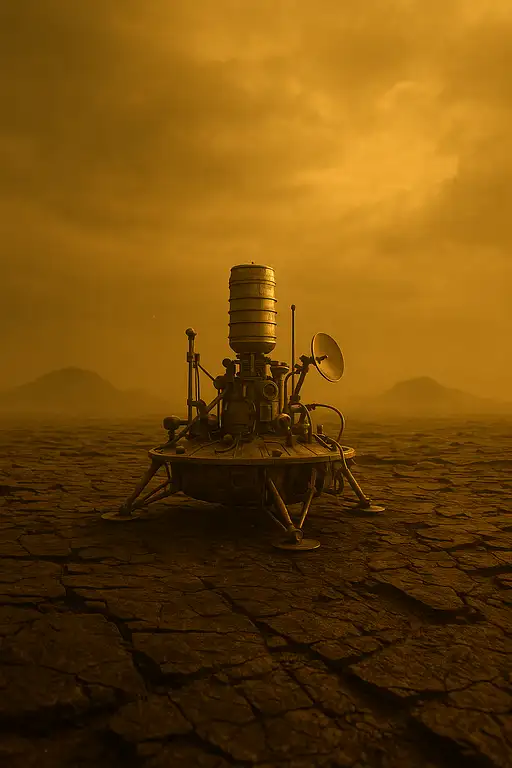
3 months ago
A lone Soviet Venera lander rests on the cracked, desolate surface of Venus under a thick, yellow-orange sulfurous sky. The air is dense and hazy, with swirling toxic clouds diffusing the sunlight into a perpetual twilight glow. The lander, with its robust, utilitarian design, circular base, and cylindrical instruments, sits quietly amidst the alien landscape, tubes and sensors reaching outward, gathering data in the oppressive heat. The ground is littered with dark, fractured rock plates, and in the distance, shadowy volcanic hills loom beneath the dense clouds. The atmosphere feels heavy, isolating, and silent, the lander a fragile piece of human engineering enduring in an unforgiving world. Cinematic lighting with volumetric haze, ultra-realistic texturing, high-detail scientific realism, shallow depth of field focusing on the lander, with soft particle dust drifting in the air, 8K, ray-traced rendering, slow camera push-in capturing the alien loneliness.

8 months ago
10. Ten of Swords – Death and Rebirth A luminous figure kneels in an endless desert, pierced by ten swords dripping molten gold instead of blood. The sun melts into the horizon in surreal, flowing patterns, signaling both an ending and a rebirth. The atmosphere glows in molten gold, twilight purples, and soft whites, with textures of cracking light, flowing sand, and liquid reflections, representing the cycle of destruction and renewal

8 months ago
(Cyberpunk, futuristic, dystopian underworld, high detail, cinematic lighting, dark and moody atmosphere) A wiry and gaunt man with sunken, exhausted eyes that have a manic glint, framed by dark circles from years of working in dimly lit back-alley clinics. His pale skin looks sickly under the flickering neon light, and his thin face is lined with tension, his lips slightly parted as if muttering to himself. His hair is unkempt, streaked with oil and grime, further emphasizing his haggard, overworked look. He wears a dingy off-white lab coat, once pristine but now stained with grease, blood, and years of unwashed grime. The fabric is frayed at the edges, hanging loosely over his thin frame. His cybernetic enhancements are crude and patched-together, a collection of exposed wiring and rusted plating barely held together. His left shoulder has a mechanical plating rig, jagged and uneven, with loose bolts and sparking neon-blue wiring protruding in places. His chipped tooth shows when he speaks, adding to his rough, jittery appearance. The background is a dark, cluttered ripperdoc lab, filled with outdated cybernetic parts, flickering monitors, and half-functioning medical equipment. The air is thick with smoke from a nearby vent, and a dull, flickering green med-lab light casts eerie shadows across the scene. A neon-red light from the alley outside spills through a cracked window, contrasting with the cold surgical glow of malfunctioning overhead lamps. The atmosphere is gritty, chaotic, and oppressive, embodying the tension of a street-level surgeon who exists between life and death, law and crime. Rendered in ultra-detailed, cinematic composition, sharp focus, 8K resolution, ray tracing, cyberpunk noir aesthetics, high contrast lighting, depth of field, volumetric lighting, intricate detailing, realistic skin texture, futuristic urban decay, science fiction concept art, hyper-realistic digital painting, dramatic chiaroscuro lighting, neon reflections, moody atmosphere, cybernetic enhancements, grunge aesthetic. Negative Prompt: (bad composition, low detail, low resolution, deformed anatomy, distorted features, asymmetrical face, extra limbs, missing fingers, unrealistic eyes, unnatural skin texture, overly stylized, washed-out colors, blurry, poorly rendered cybernetics, uncanny valley, cartoonish, low-quality render, watermark, text, overexposed lighting, excessive glow, lack of contrast, amateurish design, low effort, duplicate elements, broken limbs, unbalanced composition, generic design, bad perspective, flat shading, soft focus, dull colors, clean or polished cybernetics, generic futuristic doctor, overly heroic pose, pristine environment)
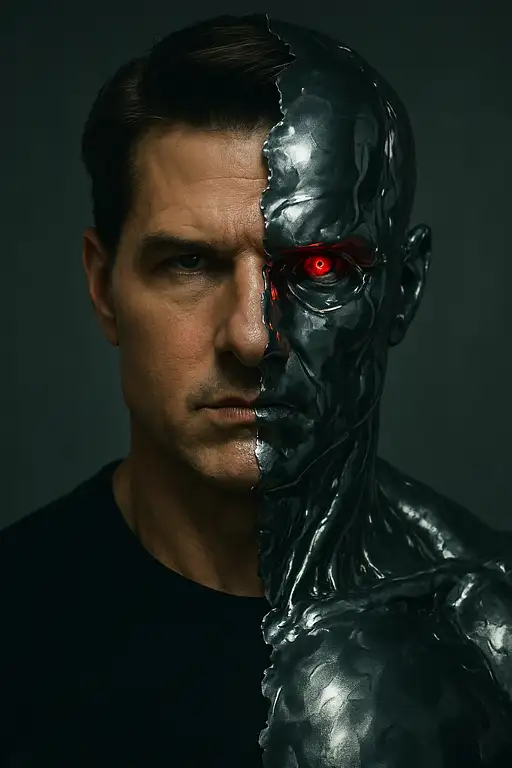
3 months ago
"subject": { "name": "Tom Cruise", "pose": "front-facing close-up", "expression": "calm, composed, intense focus, quiet menace", "symmetry": "perfectly symmetrical, face divided vertically" }, "style": { "left_half": { "visual_style": "hyper-realistic", "features": "lifelike skin textures, sharp cheekbones, piercing eyes", "lighting": "cinematic key lighting from above and side, moody shadows", "mood": "cold, authoritative, grounded in realism" }, "right_half": { "visual_style": "liquid metal, futuristic, reflective", "features": "smooth surface, chrome sheen, subtle motion effect", "inspiration": "T-1000 from Terminator 2" }, "division_line": { "style": "jagged, organic, like torn steel or cracking ice", "symbolism": "fusion of human and machine" } }, "camera": { "lens": "85mm prime", "aperture": "f/1.8", "focus": "sharp on eyes", "framing": "tight headshot with minimal headroom" }, "lighting": { "type": "dramatic, directional", "quality": "hard light on left side, metallic reflections on right", "background": "muted, minimal — soft gray gradient to isolate subject" }, "post_processing": { "skin_detail": "preserved on left half", "reflectivity": "animated glimmer or subtle motion blur on metal side", "contrast": "high contrast between organic and artificial" }, "aspect_ratio": "4:5", "moodboard_tags": [ "sci-fi portrait", "man vs machine", "Terminator T-1000", "Tom Cruise hero shot", "cinematic close-up", "hyperreal vs abstract" ]

6 months ago
((gritty, hyperrealistic painting:1.5)), ((Hulk and Superman locked in a brutal power struggle:1.5)), both hands clasped, fingers interlocked in a violent test of strength, muscles straining, tendons stretched to the limit. Superman, bruised, grounded, is down on one knee, his body twisting with resistance, arms trembling as he holds back the massive force bearing down on him. His blue suit is torn, his face bloodied, hair matted with sweat and soot, but his gaze is clear and defiant—no glowing eyes, only human resolve. The Hulk towers over him, full height—3 meters tall, 500 kilograms of brute muscle, drenched in sweat, skin streaked with grime and ash. His monstrous body looms with dominance, feet planted wide, both arms pressing down, veins bulging, face twisted in a roar of exertion. His skin cracks around his fists from the sheer pressure, saliva flying from his mouth as he snarls through clenched teeth. The ground beneath Superman’s knee is shattered, pressed inward by the weight. Shockwaves ripple through the dust, small stones hover in midair. The scene is dense with smoke, ash, and heat distortion, the ambient firelight casting flickering shadows over their bodies. Style: painted like an epic oil tableau—Caravaggio-like lighting, Repin’s anatomical drama, Beksiński’s apocalyptic ambiance. Every detail captured: grit on skin, blood at the lip, wrinkles in fabric, cracked stone, drifting embers, clenched fingers locked in struggle. Lighting: heavy chiaroscuro—low directional light from fires around them, long shadows falling across Superman’s face, rim lighting highlighting Hulk’s upper body, emphasizing the scale difference without diminishing the tension. Camera angle: low and close, from Superman’s left side, showing his knee pressed into shattered ground, arms lifted to hold off Hulk’s crushing weight. Hulk fills the vertical space, Superman dominates the emotional weight—a visual of pressure and refusal to yield. Art direction for Flux: – Hulk is 3m tall, 500kg, physically overwhelming, rendered with full weight and scale – Superman is human-scale, on one knee, but braced and locked in—the underdog with unbreakable resolve – Style: dark painterly realism, anatomical accuracy, no stylization, no superpowers shown – Textures: bruised flesh, torn cloth, cracked stone, sweat, grit, tension in the hands and faces – Environment: scorched battlefield, ambient smoke, sparks, fractured terrain, faint firelight – Theme: mythic struggle, physical scale vs inner will—no victor yet, only raw contest

5 months ago
A masterpiece, best quality, official art, extremely detailed 8k wallpaper, absurdres, 8k resolution. A massive clothed with halter and skirt female figure lying on her side, sculpted from weathered stone and earth, partially covered in moss and grass. Her body blends seamlessly into the surrounding terrain — hills and ridges rise from her limbs, and her stone dress flows like carved rock across the landscape. Wildflowers grow in cracks along her form. Her face is calm and ancient, partially worn by erosion, like a monument shaped by time. Realistic lighting, photoreal textures, dramatic foreground focus with a sweeping natural background.
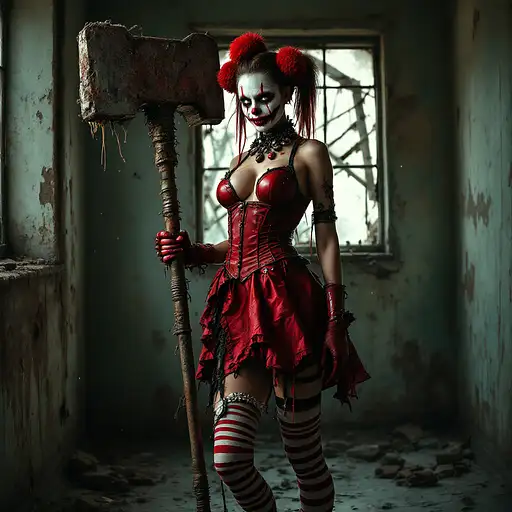
8 months ago
Dark art depiction of a scary Spartan Mecha girl, wearing a revealing red corset and tattered skirt, red and white striped thigh-high stockings, and a red pom-pom hair accessory, her face painted with scary clown makeup featuring sunken eyes and a disturbing smile, holding a large sledgehammer with a worn and rusty head, standing in an abandoned, decaying room with peeling paint and a dirty, cracked window behind her, {dust particles floating in the dim light}, highly detailed textures, inspired by Gothic horror and surrealism, dramatic backlighting that casts long shadows, medium shots, 4K resolution, haunting and unsettling atmosphere
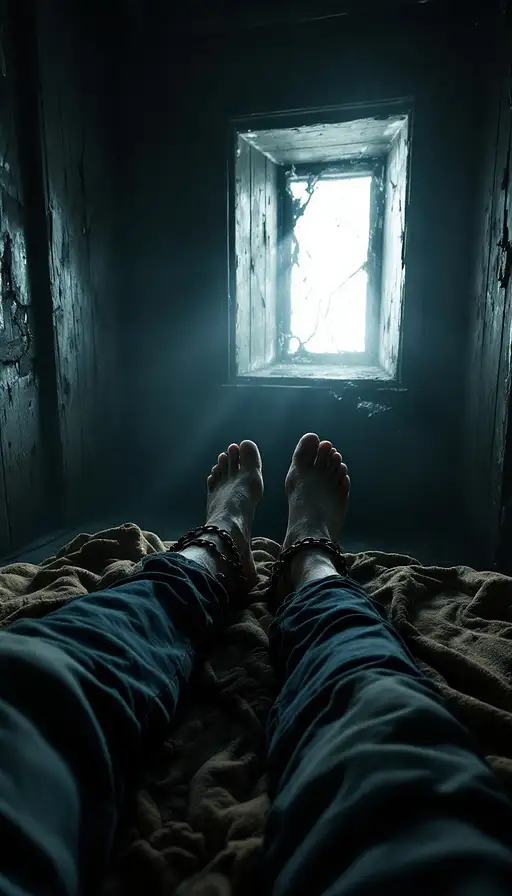
7 months ago
First-person POV of waking up in a damp, 19th-century abandoned lighthouse tower. The camera shows your legs stretching on a tattered wool blanket, with rusty chains around your ankles. The space is dimly lit, with weathered wooden walls and a cracked, fogged window in the background. The sound of crashing waves echoes faintly, and a weak beam of sunlight filters through the misty glass. Highly realistic, gritty textures, high contrast between light and shadow

8 months ago
3d woman in Chains with human and Chains shaped branches, in the style of medical imaging film., sebastian errazuriz, detailed anatomy, intricate black and white illustrations, michael eastman, rtx on, ballet academia Weathered rustic wall, emerging female face blending seamlessly with the texture of the wall, wax and clay-like details, intricate details, realistic sculpted appearance, subtle cracks and imperfections, earthy tones, soft natural lighting casting subtle shadows, artistic interpretation, high definition digital art that evokes a sense of mystery and surrealism., conceptual art, fashion, cinematic

8 months ago
A surreal, black-and-white composition blending the raw emotion of Peter Lindbergh, the dreamlike distortion of Man Ray, and the textured abstraction of Mario Giacomelli. A solitary, rugged man, his weathered face and worn coat reminiscent of a Brontë novel protagonist, stands within a crumbling Celtic castle tower. The ancient stone walls, carved by time and isolation, seem to echo with forgotten voices. Before him, a translucent, ethereal female figure—a ghostly presence—emerges from the mist, her form sharp and intense, yet fading between worlds. She exudes a powerful, almost untamed aura, as if she’s a spirit both caught in and defying time. Through cracks in the stone, faint faces and symbols flicker. The sky above, stormy and chaotic, casts diffused, ghostly light, creating a cold, spectral glow. The texture is raw and grainy, reflecting the pain and longing that haunt both the man and the ghost, lost in time.

7 months ago
Each Major Arcana card will feature hyper-realistic gold, opal quartz, neon hues, silver holographic reflections, and cosmic textures, ensuring seamless cohesion with your existing collection. Salvador Dalí-Inspired Surrealism, optimized for maximum detail and dreamlike quality. Each prompt follows a structured format, ensuring consistent surrealistic themes, psychedelic aesthetics, and celestial mysticism. A luminous traveler steps off a floating, melting staircase, descending into a swirling nebula vortex. A cosmic dog formed from stardust and galaxies follows at their feet. Their staff drips molten gold, and their cloak shimmers with opal and silver reflections. The sky is filled with cracked cosmic mirrors, reflecting infinite possibilities. Salvador Dalí-inspired surrealism, ultra-detailed, cinematic lighting, 4K masterpiece.
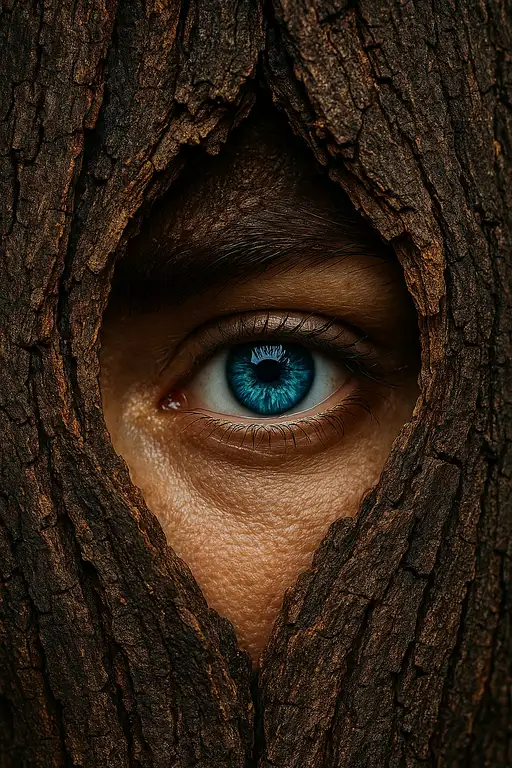
3 months ago
"subject": "extreme close-up of a vivid blue human eye peeking through cracked wooden surface", "eye_detail": { "color": "vivid blue", "reflections": "detailed and lifelike", "eyelashes": "natural, visible strands", "surrounding_skin": "realistic pores and texture" }, "environment": { "material": "rough, cracked wooden surface", "texture": "highly detailed bark grain", "lighting": "dramatic light contrast with natural shadows", "background": "dark, blurred wood interior for depth" }, "camera": { "make": "Sony", "model": "A7R V", "lens": "Sony FE 105mm macro", "settings": { "aperture": "f/2.8", "focus": "manual macro precision", "iso": "100", "shutter_speed": "1/500", "angle": "eye-level, tight macro" } }, "style": { "resolution": "8K ultra-high definition", "realism": "hyper-realistic rendering", "mood": "tense, mysterious" }, "format": "portrait 4:5", "post_processing": { "skin_tone_balance": "natural", "sharpness": "extreme clarity on eye and wood grain", "color_grading": "cool tones with warm wood contrast" }

2 months ago
ultra-detailed portrait of a porcelain-like woman, ethereal and surreal, icy white flawless skin, piercing blue eyes, elegant white hair, adorned with vivid red flowers, silver kintsugi cracks flowing across face and neck, shimmering texture, hyper-realistic, fantasy art, intricate details, soft lighting, cold and celestial aura --ar 4:5 --v 6 --q 2
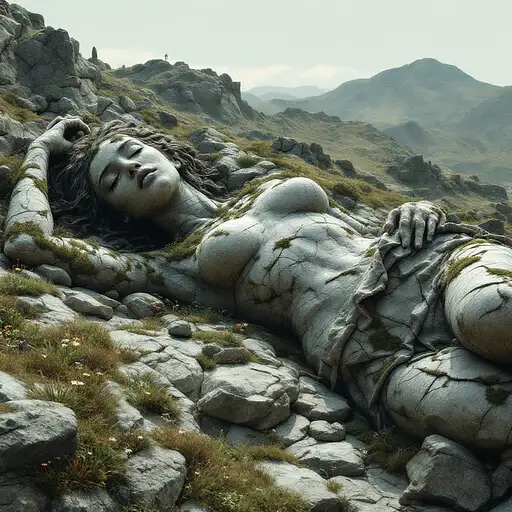
5 months ago
A masterpiece, best quality, official art, extremely detailed 8k wallpaper, absurdres, 8k resolution. A massive clothed female figure lying on her side, sculpted from weathered stone and earth, partially covered in moss and grass. Her body blends seamlessly into the surrounding terrain — hills and ridges rise from her limbs, and her stone dress flows like carved rock across the landscape. Wildflowers grow in cracks along her form. Her face is calm and ancient, partially worn by erosion, like a monument shaped by time. Realistic lighting, photoreal textures, dramatic foreground focus with a sweeping natural background.

8 months ago
3d A bird in a cage in Chains with and Chains shaped branches, in the style of medical imaging film., sebastian errazuriz, detailed anatomy, intricate black and white illustrations, michael eastman, rtx on, ballet academia Weathered rustic wall, emerging A bird in a cage blending seamlessly with the texture of the wall, wax and clay-like details, intricate details, realistic sculpted appearance, subtle cracks and imperfections, earthy tones, soft natural lighting casting subtle shadows, artistic interpretation, high definition digital art that evokes a sense of mystery and surrealism., conceptual art, cinematic
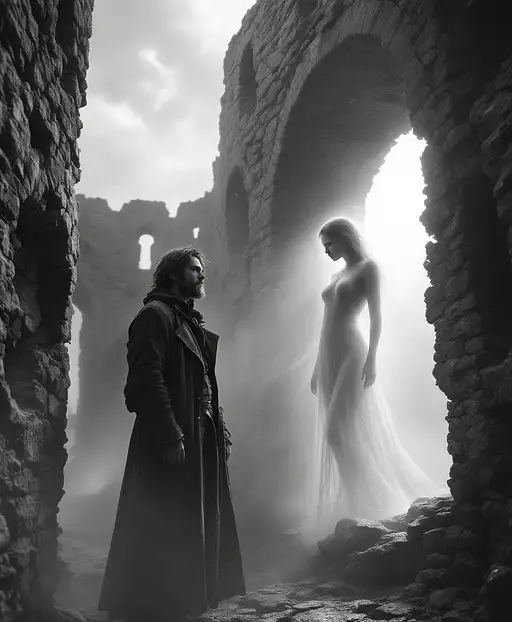
8 months ago
A surreal, black-and-white composition blending the raw emotion of Peter Lindbergh, the dreamlike distortion of Man Ray, and the textured abstraction of Mario Giacomelli. A solitary, rugged man, his weathered face and worn coat reminiscent of a Brontë novel protagonist, stands within a crumbling Celtic castle tower. The ancient stone walls, carved by time and isolation, seem to echo with forgotten voices. Before him, a translucent, ethereal female figure—a ghostly presence—emerges from the mist, her form sharp and intense, yet fading between worlds. She exudes a powerful, almost untamed aura, as if she’s a spirit both caught in and defying time. Through cracks in the stone, faint faces and symbols flicker. The sky above, stormy and chaotic, casts diffused, ghostly light, creating a cold, spectral glow. The texture is raw and grainy, reflecting the pain and longing that haunt both the man and the ghost, lost in time.
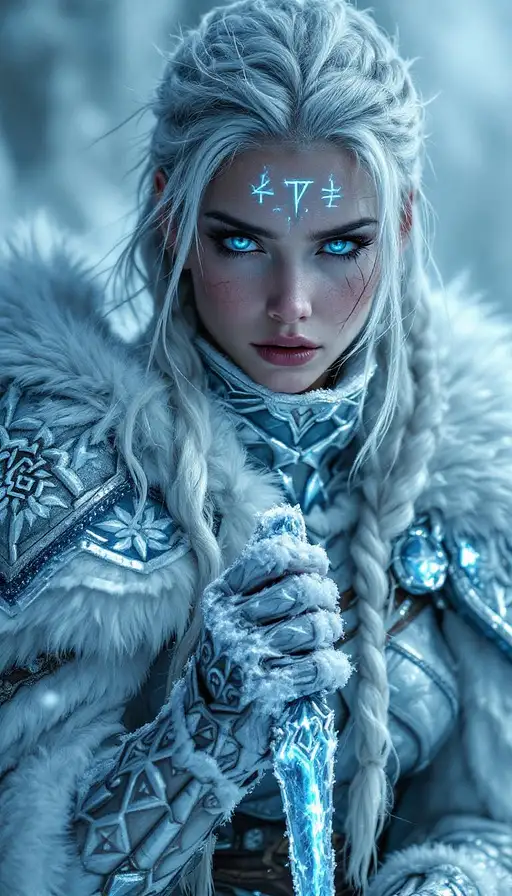
4 months ago
Incredibly beautiful Norwegian with blue eyes, beautiful blue eyes, with perfect iriseslong eyelashes, black eyeliner, freckles. A cinematic digital artwork featuring a resilient, female frost warrior in a resolute yet weary, battle-hardened pose, set against a desolate, ice-covered, arctic backdrop with a cold, glacial blue glow. The subject, a humanoid character with long, braided white hair and piercing, icy blue eyes, embodies a fusion of elemental power and warrior spirit. The intricate, silver and ice-blue armor, with a crystalline, frost-like texture, covers the entire body except for the face, which is partially visible, wind-chapped and marked by faint, glowing blue frost patterns on the forehead and cheekbones. A tattered, white fur cloak with a prominent, stylized frost rune on the shoulder adds to the harsh, arctic atmosphere. In their right hand, they grip a cracked, frost-covered greats word, pointing downward, surrounded by a swirling mist of ice crystals, casting sharp, icy shadows on the frozen surroundings. The background is a vast expanse of cracked ice, jagged ice formations, and snow-covered mountains, with hints of blizzards and strong winds, amplifying the sense of isolation and elemental power. The lighting is focused on the character, emphasizing the textures of the armor, creating a sense of depth and chilling realism, a playfully shy look. Perfect white teeth.
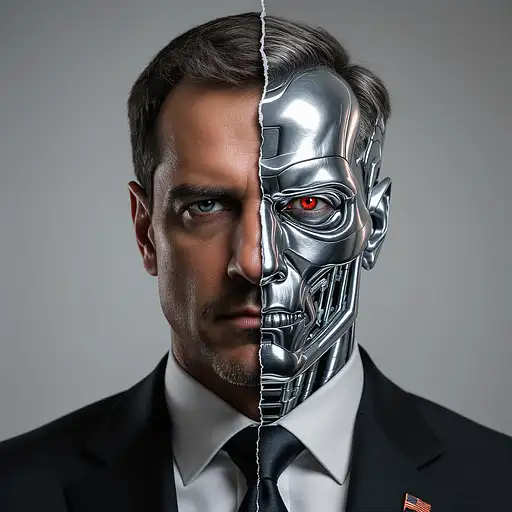
3 months ago
A dramatic, front-facing close-up portrait of Mariano Rajoy in a suit, reminiscent of the T-1000 from Terminator 2. The composition is perfectly symmetrical, with his face divided vertically into two distinct visual styles. The left half is hyper-realistic, emphasizing lifelike skin textures, sharp cheekbones, and piercing, determined eyes under cinematic lighting that enhances his cold, authoritative presence. The right half is a seamless transformation into liquid metal — smooth, reflective, and in constant, subtle motion — evoking a futuristic, shape-shifting machine. His expression is calm, composed, and exudes quiet menace and unshakable focus. The division between the two halves is jagged and organic, like torn steel or cracking ice, symbolizing the fusion of human form and advanced technology. A muted, minimal background ensures all focus remains on his iconic, intimidating face, highlighting the stark contrast between man and machine.

5 months ago
Create a meticulously staged cinematic scene with rigid symmetry and frontal, low-angle framing, emphasizing a diagonal composition (45-degree tilt) where all elements align along a single dynamic axis. Color Grading: 60% Dominant: Soft, powdery pastel pinks (Pantone 12-1109 TPX "Marshmallow") saturating the sky, snow, and TV casing. 30% Secondary: Frosted teal blues (HEX #6ECEDA) in the glacial lake, aurora, and TV screen static. 10% Accent: Mustard-yellow (Pantone 15-0950 TPX "Golden Glow") in the aurora streaks, wool tufts, and corroded metal knobs. TV Design: A 1950s Bakelite TV (matte eggshell plastic with hairline cracks) tilted diagonally (top-left corner at 10 o’clock, bottom-right submerged at 4 o’clock). Crack: A jagged diagonal fissure (2cm wide) splits the screen from top-left to bottom-right, leaking viscous, neon-bright color bar pigment (RGB values: pink #FF9EB5, teal #5FDAC3, gold #FFD700) that pools into the water below. Materials: Body: Faux-weathered plastic with chipped edges revealing rusted steel underlayers. Details: Three rotary knobs (tarnished brass, 4cm diameter) labeled "VOL," "TUNE," "POWER." Cables: Braided wool cords (undyed cream yarn, 3cm thickness) coiled around the TV’s base, fraying at the ends. Screen Imagery: Static Overlay: A 1953 RCA-style color bar test pattern (8 vertical bands) glitching every 2 seconds, causing the teal and pink bars to "melt" downward into liquid the word "Imagen-4" glitches on the screen Underlying Image: A faint, glowing topographical map (golden-yellow lines on indigo) dissolves into water that cascades from the screen’s crack, merging with the glacial lake. Environment: Glacial Lake: Semi-frozen water (translucent teal, 70% opacity) with jagged ice shards (20cm height) encircling the TV. Snowfall: Heavy, dense snowflakes (1cm diameter) falling at 45 degrees, accumulating on the TV’s top-left corner. Aurora Borealis: Three parallel bands (pink #FFB3D1, teal #7FE5E5, gold #FFE44D) in smooth sine waves, 15° tilt, 80% opacity. Sky: Ultra-high-contrast starfield (ISO 51200 noise pattern) with 2,000 visible stars (randomized 2-4px white dots). Lighting & Effects: Key Light: A frontal, low-orange sodium vapor lamp (3200K) casting sharp diagonal shadows (20° angle) from the TV onto the ice. Bloom: Halation around the aurora and screen, radius 15px, intensity 70%. Textures: Film Grain: 35mm Kodak Vision3 250D overlay (gritty, high-detail). Lens Defects: Two hairline scratches (1px width) at 15° and 75° angles, plus hexagonal lens flare (60% opacity) from the aurora. Physics & Motion: Water: Viscous fluid dynamics—the leaking color bars swirl in 5cm eddies, blending with the glacial lake. Wool: Submerged yarn floats upward in 10cm tufts, swaying at 0.5Hz frequency. Result: A hyper-detailed, reference-free scene that implicitly channels Wes Anderson’s aesthetic through obsessive symmetry, retro-kitsch materials, and a strict 60/30/10 pastel hierarchy—no director named, all style embedded in granular technical specs.

5 months ago
"Create a meticulously staged cinematic scene with rigid symmetry and frontal, low-angle framing, emphasizing a diagonal composition (45-degree tilt) where all elements align along a single dynamic axis. Color Grading: 60% Dominant: Soft, powdery pastel pinks (Pantone 12-1109 TPX "Marshmallow") saturating the sky, snow, and TV casing. 30% Secondary: Frosted teal blues (HEX #6ECEDA) in the glacial lake, aurora, and TV screen static. 10% Accent: Mustard-yellow (Pantone 15-0950 TPX "Golden Glow") in the aurora streaks, wool tufts, and corroded metal knobs. TV Design: A 1950s Bakelite TV (matte eggshell plastic with hairline cracks) tilted diagonally (top-left corner at 10 o’clock, bottom-right submerged at 4 o’clock). Crack: A jagged diagonal fissure (2cm wide) splits the screen from top-left to bottom-right, leaking viscous, neon-bright color bar pigment (RGB values: pink #FF9EB5, teal #5FDAC3, gold #FFD700) that pools into the water below. Materials: Body: Faux-weathered plastic with chipped edges revealing rusted steel underlayers. Details: Three rotary knobs (tarnished brass, 4cm diameter) labeled "VOL," "TUNE," "POWER." Cables: Braided wool cords (undyed cream yarn, 3cm thickness) coiled around the TV’s base, fraying at the ends. Screen Imagery: Static Overlay: A 1953 RCA-style color bar test pattern (8 vertical bands) glitching every 2 seconds, causing the teal and pink bars to "melt" downward into liquid with the word "Prompthero" barely visible on it. Underlying Image: A faint, glowing topographical map (golden-yellow lines on indigo) dissolves into water that cascades from the screen’s crack, merging with the glacial lake. Environment: Glacial Lake: Semi-frozen water (translucent teal, 70% opacity) with jagged ice shards (20cm height) encircling the TV. Snowfall: Heavy, dense snowflakes (1cm diameter) falling at 45 degrees, accumulating on the TV’s top-left corner. Aurora Borealis: Three parallel bands (pink #FFB3D1, teal #7FE5E5, gold #FFE44D) in smooth sine waves, 15° tilt, 80% opacity. Sky: Ultra-high-contrast starfield (ISO 51200 noise pattern) with 2,000 visible stars (randomized 2-4px white dots). Lighting & Effects: Key Light: A frontal, low-orange sodium vapor lamp (3200K) casting sharp diagonal shadows (20° angle) from the TV onto the ice. Bloom: Halation around the aurora and screen, radius 15px, intensity 70%. Textures: Film Grain: 35mm Kodak Vision3 250D overlay (gritty, high-detail). Lens Defects: Two hairline scratches (1px width) at 15° and 75° angles, plus hexagonal lens flare (60% opacity) from the aurora. Physics & Motion: Water: Viscous fluid dynamics—the leaking color bars swirl in 5cm eddies, blending with the glacial lake. Wool: Submerged yarn floats upward in 10cm tufts, swaying at 0.5Hz frequency. Result: A hyper-detailed, reference-free scene that implicitly channels Wes Anderson’s aesthetic through obsessive symmetry, retro-kitsch materials, and a strict 60/30/10 pastel hierarchy—no director named, all style embedded in granular technical specs.
